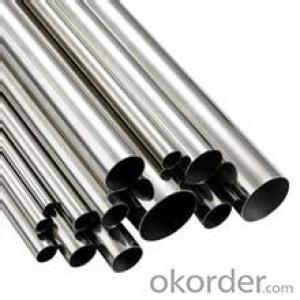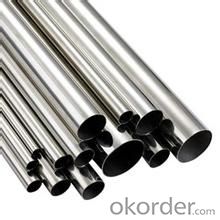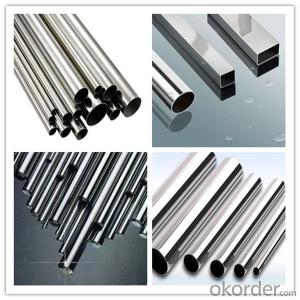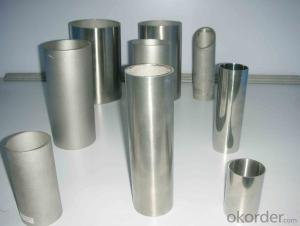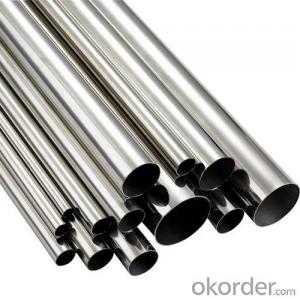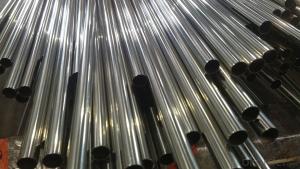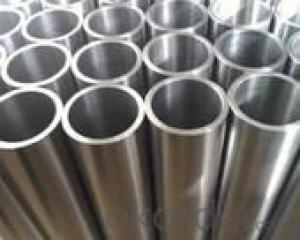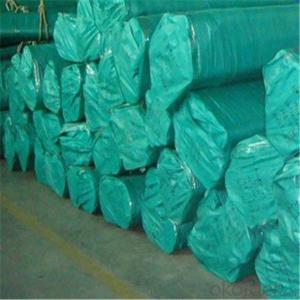316L corrosion resistant austenitic stainless steel pipe
- Loading Port:
- China main port
- Payment Terms:
- TT OR LC
- Min Order Qty:
- 20 m.t.
- Supply Capability:
- 5000 m.t./month
OKorder Service Pledge
OKorder Financial Service
You Might Also Like
AISI 316l stainless steel round pipe/tube
Product name: AISI stainless steel pipe/tube
Materials: 304, 304L, 310S, 316, 316L, 325, 273, 219 and 168
Thickness: 1, 2, 2.5, 3, 3.5, 4, 5, 6 and 8mm
Outer diameter: 6-480mm
Length: as required
Treatment: cold and hot rolled
Applications: construction upholstery, and industry instruments, such as fencing, railing,safe doors/windows, gate fittings, inside staircases, balcony balustrades, furniture, sanitary wares and kitchen wares
Standards: GB, AISI, ASTM, DIN and JIS
Sureface: 2B, BA and designer finishes
Price terms: FOB, CIF, CFR and EXW
Delivery:10-15 days after received the deposit or as quantity request.
Chemical Composition | C | Mn | P | S |
<=0.0< span="">3 | <=2.00< span=""> | <=0.0< span="">35 | <=0.03< span=""> | |
Si | Cr | N | Ni | |
<=1.00< span=""> | 16-18 | NO | 12-15 |
- Q: Can stainless steel pipes be used for wastewater treatment systems?
- Yes, stainless steel pipes can be used for wastewater treatment systems. Stainless steel is a highly durable and corrosion-resistant material, making it an ideal choice for pipes in harsh environments such as wastewater treatment plants. These pipes can withstand the corrosive nature of wastewater, including the presence of chemicals and different pH levels. Stainless steel pipes also have a smooth surface, which helps to minimize the accumulation of waste and bacteria, ensuring the efficient flow of wastewater through the system. Additionally, stainless steel is easy to clean and maintain, making it a cost-effective and reliable choice for wastewater treatment systems.
- Q: What is the difference between 316 and 316Ti stainless steel pipes?
- The main difference between 316 and 316Ti stainless steel pipes is the addition of titanium (Ti) in 316Ti. This titanium content makes 316Ti more resistant to corrosion and sensitization at elevated temperatures, making it suitable for applications where the pipes will be exposed to high temperatures. 316 stainless steel, on the other hand, does not contain titanium and is more commonly used for general-purpose applications.
- Q: What is the difference between 17-4 and 15-5 stainless steel pipes?
- The main difference between 17-4 and 15-5 stainless steel pipes lies in their chemical compositions and resulting mechanical properties. 17-4 stainless steel contains approximately 17% chromium and 4% nickel, while 15-5 stainless steel contains about 15% chromium and 5% nickel. As a result, 17-4 stainless steel has higher levels of both chromium and nickel, providing better corrosion resistance and improved strength compared to 15-5 stainless steel. However, 15-5 stainless steel offers superior toughness and ease of welding. Ultimately, the choice between these two types of stainless steel pipes depends on the specific requirements of the application and the desired balance between corrosion resistance, strength, and weldability.
- Q: Can stainless steel pipes be used in nuclear power plants?
- Yes, stainless steel pipes can be used in nuclear power plants. Stainless steel is a commonly used material in the construction of nuclear power plants due to its high strength, corrosion resistance, and ability to withstand high temperatures. Stainless steel pipes are particularly suitable for carrying coolant, gases, and other fluids within the power plant. These pipes are able to handle the demanding conditions and requirements of a nuclear power plant, including the high pressure and high temperatures that are present in certain parts of the plant. Additionally, stainless steel is resistant to the corrosive effects of radiation, making it a reliable choice for use in nuclear power plants.
- Q: Is stainless steel flexible enough for plumbing applications?
- Indeed, stainless steel proves itself to be sufficiently flexible for plumbing purposes. Renowned for their robustness and sturdiness, stainless steel pipes and fittings also possess a certain level of adaptability. This adaptability facilitates effortless installation in a wide range of plumbing systems, even those with intricate designs or confined spaces. Stainless steel pipes can be manipulated and molded without compromising their structural integrity, rendering them suitable for both residential and commercial plumbing ventures. Furthermore, stainless steel exhibits remarkable resistance to corrosion, a vital quality in plumbing scenarios where exposure to water and other corrosive substances is common. Overall, the combination of strength, durability, and flexibility that stainless steel offers makes it an excellent option for plumbing applications.
- Q: What is the difference between 304J3 and 316J3 stainless steel pipes?
- The main difference between 304J3 and 316J3 stainless steel pipes lies in their composition and corrosion resistance properties. 304J3 stainless steel is a grade of stainless steel that contains 18% chromium and 8% nickel. It is known for its excellent corrosion resistance, high strength, and good formability. This grade is commonly used in various applications, such as food processing, chemical processing, and architectural applications. On the other hand, 316J3 stainless steel is a grade that contains 16-18% chromium, 10-14% nickel, and 2-3% molybdenum. This additional molybdenum content enhances its corrosion resistance, especially against chloride environments. As a result, 316J3 stainless steel is often used in more demanding applications, such as marine environments, pharmaceutical equipment, and coastal structures. In summary, the key difference between 304J3 and 316J3 stainless steel pipes is the composition and the subsequent corrosion resistance properties. While both grades offer good corrosion resistance, 316J3 stainless steel provides superior resistance in chloride-rich environments, making it suitable for more demanding applications.
- Q: Can stainless steel pipes be insulated with foam?
- Yes, stainless steel pipes can be insulated with foam. Foam insulation is commonly used to insulate pipes of various materials, including stainless steel. Foam insulation provides thermal resistance and helps to prevent heat loss or gain from the pipes. It also helps to minimize condensation on the surface of the pipes, which can prevent corrosion. Foam insulation can be easily applied to stainless steel pipes using adhesive or tape, and it can be customized to fit the specific dimensions of the pipes. Overall, foam insulation is an effective and cost-efficient solution for insulating stainless steel pipes.
- Q: What are the different sizes available for stainless steel pipes?
- Various industrial and residential applications can be catered to with a wide range of sizes of stainless steel pipes. The sizes of stainless steel pipes typically depend on their nominal pipe size (NPS) or outside diameter (OD). The diameter of stainless steel pipes commonly ranges from 1/8 inch to 48 inches. For smaller applications or plumbing systems, stainless steel pipes with NPS 1/8, 1/4, 3/8, and 1/2 are commonly utilized. These sizes are suitable for household plumbing, water supply lines, and low-pressure applications. As the requirements increase, larger stainless steel pipe sizes are available. Sizes such as NPS 3/4, 1, 1 1/4, 1 1/2, and 2 inches are commonly employed in various industries and commercial applications. These sizes are appropriate for higher-pressure applications like hydraulic systems, oil and gas pipelines, and chemical processing plants. For industrial applications that demand even larger pipes, stainless steel pipes with sizes ranging from 2 1/2 inches to 48 inches in diameter are accessible. These large pipes are frequently used in heavy-duty applications such as petrochemical plants, power generation facilities, and large-scale construction projects. It's important to note that stainless steel pipes are also obtainable in different wall thicknesses, known as schedules. The schedule number determines the wall thickness, with higher numbers indicating thicker walls. The most common schedules for stainless steel pipes are Schedule 5, Schedule 10, Schedule 40, and Schedule 80. In conclusion, a wide range of sizes are available for stainless steel pipes, starting from 1/8 inch and going up to 48 inches in diameter. The appropriate size selection depends on the specific application and the required pressure and flow requirements.
- Q: How do stainless steel pipes compare to copper pipes?
- Stainless steel pipes are generally more durable, corrosion-resistant, and can withstand higher temperatures compared to copper pipes. Additionally, stainless steel pipes have a longer lifespan and require less maintenance. However, copper pipes have better heat conductivity and are easier to install. The choice between stainless steel and copper pipes depends on the specific application and requirements.
- Q: How do stainless steel pipes compare to carbon fiber pipes?
- Stainless steel pipes possess distinct qualities and find usage in diverse fields. Renowned for their robustness and power, they exhibit exceptional resistance to corrosion and can withstand elevated temperatures and pressures. Consequently, they prove suitable for various industries, including oil and gas, chemical, and construction. Boasting an elongated lifespan and the ability to bear heavy loads, stainless steel pipes emerge as a reliable option for numerous applications. Nevertheless, their relatively hefty weight necessitates additional support structures. Conversely, carbon fiber pipes, characterized by their lightness and high strength-to-weight ratio, serve as an alternative. Crafted from carbon fibers embedded in a resin matrix, they yield a formidable and rigid material. Aerospace, automotive, and sports equipment industries commonly employ carbon fiber pipes. Their lightweight nature permits enhanced fuel efficiency in vehicles and augmented performance in sports equipment. However, carbon fiber pipes prove pricier than their stainless steel counterparts and may lack the desired resilience to extreme temperatures or corrosive surroundings. To summarize, stainless steel pipes excel in durability and corrosion resistance, making them well-suited for demanding tasks. Carbon fiber pipes, on the other hand, offer lightweight construction and a commendable strength-to-weight ratio, rendering them ideal for weight reduction-focused applications. Ultimately, the choice between stainless steel and carbon fiber pipes hinges on specific requirements and the trade-offs between cost, weight, and performance.
Send your message to us
316L corrosion resistant austenitic stainless steel pipe
- Loading Port:
- China main port
- Payment Terms:
- TT OR LC
- Min Order Qty:
- 20 m.t.
- Supply Capability:
- 5000 m.t./month
OKorder Service Pledge
OKorder Financial Service
Similar products
Hot products
Hot Searches
Related keywords
